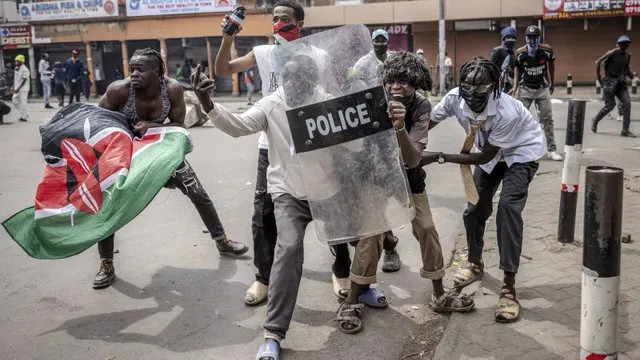
Kenyan Youth Demonstrate Against New Cabinet
2024-08-08 00:00- Youth in Kenya have taken to the streets for the eighth consecutive week to protest against the newly sworn-in cabinet by President William Ruto.
- The demonstrations highlight discontent with the government's recent decisions and perceived lack of representation.
- These protests signify growing youth activism in Kenya demanding better governance.
Express your sentiment!
Insights
Young protesters in Kenya took to the streets for the eighth consecutive week on Thursday, coinciding with President William Ruto's swearing-in of a new cabinet. Demonstrations erupted in Nairobi's city center, where police deployed tear gas to disperse crowds, as many businesses remained shuttered. The protests, dubbed the "Nane Nane March" in reference to the date, have been fueled by calls on social media for a significant show of dissent. Prominent protester Kasmuel McOure emphasized the movement's goal of fighting for rights and liberation. The protests began nearly two months ago, initially sparked by opposition to a now-retracted Finance Bill. However, the movement has evolved into a broader outcry against corruption, rising living costs, and police brutality, attracting a diverse group of participants, primarily from the Gen Z demographic. The Kenya National Commission on Human Rights reported that at least 61 individuals have died in the unrest, with accusations of excessive police force against largely peaceful demonstrators. As tensions escalated, police warned of potential criminal infiltration during the protests, pledging to maintain security. Acting police chief Gilbert Masengeli urged the public to exercise caution in crowded areas. Meanwhile, President Ruto's recent cabinet appointments, which included reappointing several ministers amid public discontent, have further fueled outrage among protesters, who view the media's framing of their actions as "anti-government" as misleading. Ruto defended his cabinet, asserting that it would unite the country and unlock its potential.
Contexts
Since taking office, President William Ruto has faced significant challenges, particularly related to his economic agenda. His plans were particularly jeopardized by proposed tax hikes, leading to public discontent and protests. The unrest escalated dramatically after the initial protests, which resulted in at least 30 deaths by June 28, 2024. Despite withdrawing the tax bill on June 30, violence continued, resulting in 39 fatalities. The conflict heightened as police brutality concerns grew, culminating in the resignation of the police chief on July 12, 2024. In response to the backlash, Ruto dismissed most of his cabinet on July 11, aiming to stabilize the situation by forming a more unified administration. However, protests continued for eight consecutive weeks, as frustrated youth in Nairobi expressed their concerns over the government's inaction regarding pressing societal issues, reflecting a deeper division within the community.